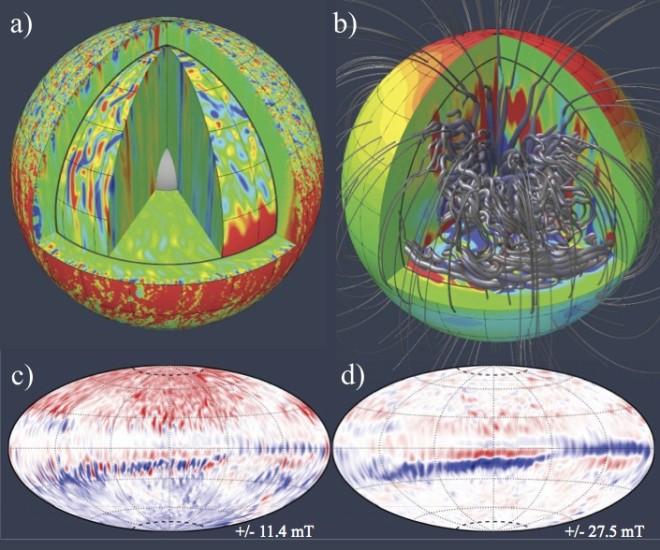.

T. Gastine, et. al. “Explaining Jupiter’s MAGNETIC field and equatorial jet dynamics,” Geophysical Research Letters, doi: 10.1002/2014GL060814
.
The image above shows a simulation of Jupiter’s magnetic field, whose intricate complexities make it extremely difficult to accurately model. While it may look like the gas giant is vomiting up some enormous space worms, the visualization is actually capturing details of the gas giant’s magnetism with greater precision than ever before.
Everything’s bigger about Jupiter. Along with being the SOLAR SYSTEM’s largest planet, the gas giant also generates an extremely convoluted magnetic field 18,000 times more powerful than our own. Jupiter’s magnetic field extends more than 4 million miles from its surface. Charged particles emanating from the sun are deflected around this magnetosphere, creating a cavity that is the second largest continuous structure in the SOLAR system (the biggest is the sun’s heliosphere, a similar cavity that our local star carves out of the interstellar medium).
The Earth generates a magnetic field by the convection of molten nickel-iron alloys in its outer core. Jupiter’s outer core is also thought to be responsible for its enormous magnetic field, though it is LIQUID hydrogen crushed by intense pressure into a metallic form that generates the magnetism rather than iron compounds. In addition, the gas giant’s surface is buffeted by powerful winds and huge storms, like the famous Great Red Spot. Scientists believe that these surface winds interact with the metallic liquid hydrogen below to stimulate some of the secondary properties of the magnetic field.
But most previous models have tended to treat the upper winds and the metallic hydrogen separately, with researchers focusing on the dynamics of the core, which is largely responsible for the field. This has led to simulations of Jupiter’s magnetic field that are either too strong, lopsided in one direction, or don’t contain all the OBSERVED complexity of the actual field. The new analysis looks at how the upper layers influence the lower ones, using a more inclusive view of the planet’s interior.
Of course Jupiter is a cloudy world, and we don’t really have a great idea of what’s going on down there. Models of Jupiter’s interior are hotly CONTESTED among scientists. But this new simulation both accurately reproduces Jupiter’s large-scale magnetic field and makes specific predictions, including the existence of magnetic bands yet to be observed by spacecraft. NASA’s Juno mission, a probe sent to study Jupiter’s MAGNETIC field, will test many of these predictions when it arrives in 2016, perhaps revealing some of the hidden complexities of this gas giant.
Quelle: WIRED
4160 Views

